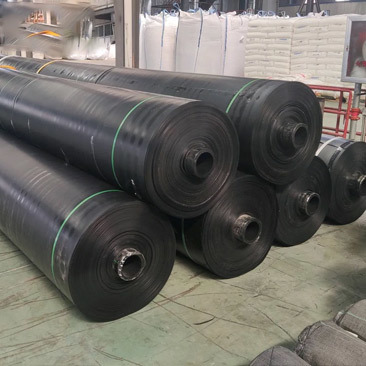Discover the Transformative Benefits of Using Geomembrane Material in Construction Projects
Release time:
2025-09-22
Discover the Transformative Benefits of Using Geomembrane Material in Construction Projects Table of Contents 1. Introduction to Geomembrane Materials 2. What is Geomembrane? Understanding its Composition and Types 3. Key Benefits of Using Geomembrane in Construction 3.1 Superior Waterproofing Capabilities 3.2 Environmental Protection and Sustainability 3.3 Cost-Effectiveness and Long-
Discover the Transformative Benefits of Using Geomembrane Material in Construction Projects
Table of Contents
1. Introduction to Geomembrane Materials
2. What is Geomembrane? Understanding its Composition and Types
3. Key Benefits of Using Geomembrane in Construction
3.1 Superior Waterproofing Capabilities
3.2 Environmental Protection and Sustainability
3.3 Cost-Effectiveness and Long-Term Durability
4. Applications of Geomembrane Materials in Construction
4.1 Landfills and Waste Management
4.2 Water Reservoirs and Ponds
4.3 Roads and Civil Engineering Projects
5. Installation Process of Geomembrane
6. Common Challenges and Considerations in Using Geomembranes
7. Future Trends in Geomembrane Usage
8. Frequently Asked Questions (FAQs)
8.1 What materials are used in geomembranes?
8.2 How long do geomembranes last?
8.3 Are geomembranes environmentally friendly?
8.4 Can geomembranes be repaired if damaged?
8.5 How do I choose the right geomembrane for my project?
9. Conclusion
1. Introduction to Geomembrane Materials
In the ever-evolving landscape of construction, **geomembrane materials** have emerged as a critical component in various projects. These materials, primarily designed to manage environmental concerns, are increasingly becoming a go-to solution for engineers and contractors alike. Their ability to provide superior waterproofing and durability makes them indispensable in modern construction practices. In this article, we will delve into the many benefits of using geomembranes, exploring their composition, applications, and the reasons behind their growing popularity.
2. What is Geomembrane? Understanding its Composition and Types
Geomembranes are synthetic membranes used as barriers to prevent the movement of fluids in soil and rock formations. They are typically made from materials such as high-density polyethylene (HDPE), linear low-density polyethylene (LLDPE), and polyvinyl chloride (PVC). These materials are known for their **high tensile strength**, flexibility, and resistance to environmental stressors, making them ideal for various construction applications.
There are several types of geomembranes, each tailored to specific applications. The most common include:
- **HDPE Geomembranes**: Known for their robustness and UV resistance, ideal for landfill applications.
- **LLDPE Geomembranes**: Offer enhanced flexibility, making them suitable for complex landscapes.
- **PVC Geomembranes**: Highly adaptable, used in applications requiring chemical resistance.
3. Key Benefits of Using Geomembrane in Construction
The adoption of geomembranes in construction projects comes with a myriad of benefits. Here, we will explore the most significant ones.
3.1 Superior Waterproofing Capabilities
One of the primary advantages of geomembranes is their exceptional waterproofing properties. These materials provide a reliable barrier against water infiltration, thus protecting the integrity of structures. Whether used in pond linings or landfill caps, geomembranes prevent costly water damage and preserve the surrounding environment.
3.2 Environmental Protection and Sustainability
Geomembranes play a pivotal role in environmental protection. By effectively containing contaminants, they safeguard groundwater and soil from pollutants. This aspect is crucial in landfill management, where the prevention of leachate migration is paramount. Furthermore, the sustainability of geomembranes contributes to eco-friendly construction practices, reducing waste and promoting responsible resource management.
3.3 Cost-Effectiveness and Long-Term Durability
Investing in geomembrane materials can lead to significant cost savings over time. Their durability and resistance to environmental factors mean that they require less maintenance and have a longer lifespan compared to traditional materials. This longevity translates into lower replacement costs and enhanced project efficiency, making geomembranes a smart choice for any construction project.
4. Applications of Geomembrane Materials in Construction
Geomembranes have a wide range of applications in the construction industry. Their versatility allows them to be employed in various scenarios, including:
4.1 Landfills and Waste Management
In landfill construction, geomembranes serve as a critical component of containment systems. They are used to line landfills, preventing leachate from contaminating soil and groundwater. The robust nature of these materials ensures that waste management practices adhere to environmental regulations.
4.2 Water Reservoirs and Ponds
Geomembranes are also utilized in the construction of water reservoirs and retention ponds. Their waterproofing capabilities ensure that water is contained effectively, reducing evaporation and minimizing leakage. This application is particularly vital in regions experiencing water scarcity.
4.3 Roads and Civil Engineering Projects
In civil engineering, geomembranes are used for various purposes, including erosion control and soil stabilization. They help to reinforce road structures, preventing soil movement and enhancing the durability of the roadbed. This application is essential in areas with challenging soil conditions.
5. Installation Process of Geomembrane
The correct installation of geomembrane materials is crucial for their effectiveness. The process typically involves several steps:
1. **Site Preparation**: The installation site must be cleared and leveled to ensure a smooth surface. Any sharp objects that may puncture the geomembrane should be removed.
2. **Material Selection**: Choosing the appropriate type of geomembrane based on the project requirements is essential. Factors such as chemical exposure, environmental conditions, and project specifications should be considered.
3. **Seaming**: Geomembranes can be joined using welding techniques or adhesive methods. The seams must be tested for integrity to ensure a secure barrier.
4. **Placement**: The geomembrane is carefully placed on the prepared surface, ensuring no wrinkles or folds that could compromise its effectiveness.
5. **Inspection**: Finally, a thorough inspection is conducted to confirm that the installation meets all specifications and quality standards.
6. Common Challenges and Considerations in Using Geomembranes
While geomembranes offer numerous advantages, there are challenges associated with their use. Understanding these challenges can help project managers mitigate risks effectively.
- **Environmental Conditions**: Extreme weather conditions can impact the performance of geomembranes. Proper selection and installation can alleviate many of these concerns.
- **Installation Quality**: Ensuring high installation standards is vital. Poor installation can lead to leaks and reduce the overall effectiveness of the geomembrane.
- **Chemical Compatibility**: It is essential to consider the chemical environment in which the geomembrane will be used. Not all geomembranes are resistant to every chemical, and compatibility testing is crucial.
7. Future Trends in Geomembrane Usage
The future of geomembranes in construction looks promising. Innovations in material science are leading to the development of even more versatile and durable geomembrane options. Biodegradable geomembranes are also gaining traction, aligning with the global push towards sustainability. As construction practices evolve, geomembranes will likely play an increasingly significant role in ensuring environmentally responsible development.
8. Frequently Asked Questions (FAQs)
8.1 What materials are used in geomembranes?
Geomembranes are primarily made from synthetic materials such as HDPE, LLDPE, and PVC, chosen for their durability and resistance to environmental stressors.
8.2 How long do geomembranes last?
The lifespan of geomembranes can vary based on material and environmental conditions, but they generally last between 20 to 30 years or more when properly installed and maintained.
8.3 Are geomembranes environmentally friendly?
Yes, geomembranes are designed to protect the environment by preventing soil and groundwater contamination, making them an essential component of sustainable construction practices.
8.4 Can geomembranes be repaired if damaged?
Yes, geomembranes can be repaired through various methods, including patching with compatible materials or welding new sections onto the existing membrane.
8.5 How do I choose the right geomembrane for my project?
Selecting the appropriate geomembrane depends on factors such as the project’s environmental conditions, chemical exposure, and specific performance requirements. Consulting with a specialist can help ensure the right choice.
9. Conclusion
The use of geomembrane materials in construction projects offers transformative benefits that cannot be overlooked. Their **superior waterproofing capabilities**, environmental protection, and long-term durability make them an ideal choice for various applications, from landfills to water reservoirs. As the construction industry continues to evolve, geomembranes will remain at the forefront, promoting sustainable practices and safeguarding our environment. By understanding the benefits and applications of geomembranes, construction professionals can make informed decisions that enhance project success and environmental responsibility.






